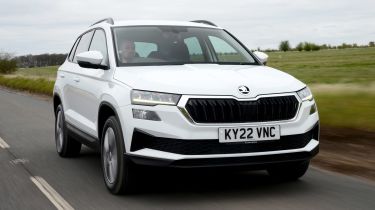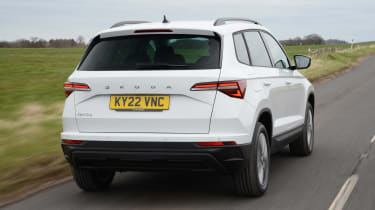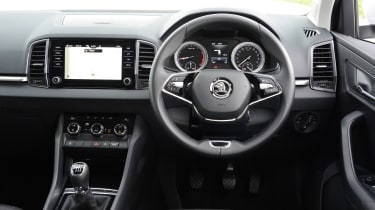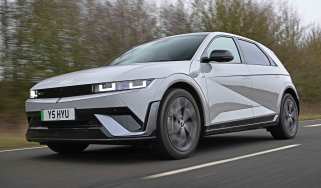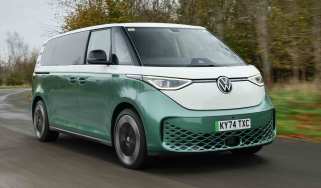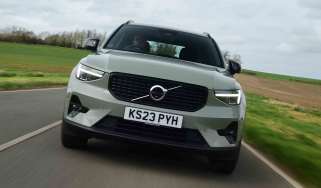New Skoda Karoq 2022 review
The Skoda Karoq has been facelifted for 2022, but is the popular mid-size SUV now better than ever?

Verdict
If you already own a Karoq don’t worry, because the changes for this round of updates to Skoda’s family SUV are minor and we wouldn’t feel compelled to chop in the previous version for this new model in a hurry. However, the brand’s latest entry into the competitive family-crossover sector continues to rank among the very best when it comes to practicality, comfort and value for money. And this 1.0 TSI model adds the potential for low running costs into the mix, which will be important for many prospective buyers at the moment.
Among a very congested field of family crossovers, the Skoda Karoq is a car that we rate highly. However, with rivals as talented as the Hyundai Tucson, Nissan Qashqai and Peugeot 3008, there’s no point in getting complacent – which is why Skoda has given its popular SUV a facelift. The Czech brand reckons it has found room for improvement, and so has made subtle changes across the board.
The updates are there to see from the outside where, much like the bigger seven-seat Kodiaq SUV, the Karoq sports a wider, more upright grille. The bumpers have also been reprofiled, while the head and tail-lights have been tweaked; the former have a little stepped element to their lower edge. For the first time on the Karoq, advanced matrix LED lighting technology is available, and there are also two new colours to choose from: Phoenix Orange and Graphite Grey.
However, the changes aren’t purely cosmetic – they’re designed to bring an aerodynamic benefit as well. A combination of smooth underbody cladding, an extended rear spoiler and even aero covers for the alloy wheels have improved aerodynamic efficiency by nine per cent. This should bring an improvement in fuel consumption – especially at motorway speeds.
Used - available now

2020 Skoda
Karoq
26,817 milesAutomaticDiesel1.6L
Cash £15,895
2020 Skoda
Karoq
41,210 milesAutomaticDiesel1.6L
Cash £13,900
2025 Skoda
Karoq
6,434 milesAutomaticPetrol1.5L
Cash £25,649
2022 Skoda
Karoq
33,334 milesAutomaticPetrol1.5L
Cash £19,420Step inside and you’ll find the basic layout is the same as before, but there are new interior trims to subtly set it apart from the old car, including the faux brushed-metal dashboard inserts and crosshatch-effect metallic door panels on the SE Drive trim level pictured. There’s also a two-spoke steering wheel lifted from the Octavia, wireless Apple CarPlay and Android Auto, and USB-C ports – including one on the rear-view mirror for plugging a dash cam into.
Among the latest upholstery options is a new Eco pack, which means the seat covers are partly made from recycled bottles. This will be sure to bring a pleasing glow to owners; one that, thanks to a more comprehensive ambient-lighting package, passengers in the back can now bask in, too. Everything feels solid enough, although there are more hard plastics in this cabin than in rivals such as the 3008 or new Qashqai.
As ever, the Karoq boasts a good number of well thought-out touches as part of Skoda’s Simply Clever approach to interior design. The front door pockets can hold a 1.5-litre bottle and have little elastic straps to hold items in place, and there’s even space for a little clip-on waste bin.
Rear-seat passengers are provided with folding tray tables and tablet/smartphone holders. Optional (£745) VarioFlex back seats come with a 40:20:40 split, and can even be completely removed to reveal a total load volume of 1,810 litres. In its standard five-seat layout, the Karoq’s 521-litre (588 with the VarioFlex seats) boot is better than a Qashqai’s, and a reversible boot mat has a rubberised side, which is handy when carrying grubby items. There is quite a step in the floor when the seats are folded flat, though.
Inside, because the Karoq’s ‘body in white’ hasn’t changed, the fact it is still based on the brand’s MQB platform means passenger space is just as good as before. There’s a fair level of head and legroom – it’s certainly up there with the best in this class – while doors that open wide mean strapping children into child seats shouldn’t be a back-breaking exercise.
Under the bonnet, there’s a choice of two petrol and three diesel engines. The 1.0-litre TSI we’re driving here is the entry-level unit, and while there are versions that climb to 187bhp (but still no sporty vRS model, unlike with its Kodiaq big brother), this 108bhp engine should be adequate for most people’s needs. It’s a quiet unit – even under hard acceleration – and is fairly smooth for a three-cylinder, too. The six-speed manual gearbox it’s paired with is light and fairly precise, and it contributes to a car that generally feels very easy to drive.
Of course, with a claimed 0-62mph time of 11.2 seconds you’d hardly call it fast, but the tiny turbocharger helps deliver a torque output of 200Nm. This is enough to keep the Karoq making good mid-speed progress at sensible revs so as not to disrupt the 1.0 TSI unit’s relatively strong refinement.
Around town there’s enough flexibility to stop you constantly changing gears, so those on a tight budget won’t be short-changed by this entry-level unit. In fact, with the way fuel costs are going up, you might be quids in; Skoda claims efficiency of up to 48.7mpg (with CO2 emissions of 132g/km), and we achieved relatively close to this first figure on test. This indicates that the Karoq should be relatively affordable to run.
While top-spec models are now available with adaptive dampers and progressive steering, the Skoda’s ride-and-handling balance remains much the same as it was before. In other words, it strikes a good compromise between safe and secure cornering, and a smoothness over bumps that is towards the top of its class.
The ride is particularly soft on testing Tarmac, but it remains well controlled across harsh surfaces, while knocks from the suspension are well isolated. Wind and road noise is well suppressed, too, although the Skoda is slightly behind the Tucson in this area. The Karoq is a little more agile than the Hyundai, however – even though that’s not exactly a deal-breaker for most buyers – but overall it’s a very relaxing place in which to cover long distances.
Equipment levels have been given a boost thanks to the introduction of kit such as an electrically adjustable driver’s seat and three-zone climate control. SE Drive trim doesn’t get those features – nor a digital dash – but it has more than enough standard kit, including 17-inch alloy wheels, LED headlights, an eight-inch touchscreen infotainment system (which is similar to its predecessor, because the tech hasn’t moved on all that much), cruise control plus front and rear parking sensors. There are also the typically thoughtful extras we’ve come to expect from Skoda, including an ice-scraper, and an umbrella under the passenger seat.
Place a £3,000 deposit on a three-year PCP, and based on a representative finance example from Skoda you’ll pay £362 per month. That undercuts the entry-level Vauxhall Grandland – a car that does give a little more power from its 1.2-litre turbo engine – by £67 per month.
| Model: | Skoda Karoq 1.0 TSI 110 SE Drive |
| Price: | £26,255 |
| Engine: | 1.0-litre 3cyl turbo petrol |
| Power/torque: | 108bhp/200Nm |
| Transmission: | Six-speed manual, front-wheel drive |
| 0-62mph: | 11.2 seconds |
| Top speed: | 118mph |
| Economy: | 48.7mpg |
| CO2: | 132g/km |
| On sale: | Now |

